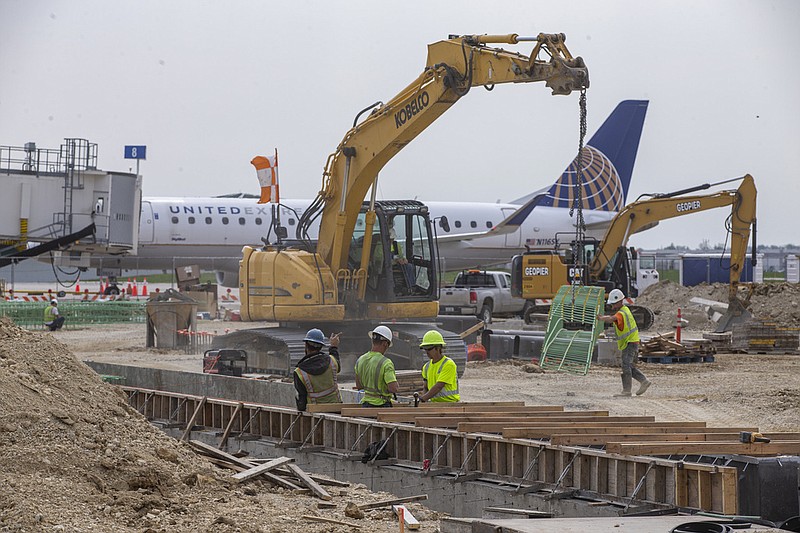The U.S. labor market sent conflicting signals in May as payrolls surged along with joblessness, giving Federal Reserve officials more reason to pause interest-rate increases.
Nonfarm payrolls increased 339,000 last month after an upwardly revised 294,000 advance in April, a Bureau of Labor Statistics report showed Friday. The unemployment rate rose to 3.7%, while wage growth slowed.
The advance was broad-based, reflecting gains in professional and business services, government and health care.
Markets reacted to the advance in payrolls, with Treasury yields jumping after the report. Traders raised their bets of the Fed bumping rates by the end of July. Bets on a June increase also rose, though investors still leaned toward expecting a pause.
For the Fed, however, policymakers will also be looking at the surge in the unemployment rate, which was the biggest one-month increase since April 2020. There were 440,000 more people out of a job in May, also the largest monthly rise since the onset of the pandemic.
Even though labor demand has remained resilient, it's unclear how long that will last. With a credit crunch threatening to halt the expansion and more companies planning to let workers go, hiring and pay gains may slow substantially in the coming months.
The mixed nature of the report may validate Fed Chair Jerome Powell's approach to pausing interest-rate increases to assess the effect of 5 percentage points of increases so far. Other officials have also voiced support for holding rates steady at this month's meeting, while leaving the door open to resume tightening in July, as price pressures remain robust and the threat of a U.S. debt default has been avoided.
The jobs report is one of the last major releases policymakers will see before they convene on June 13 for a two-day meeting. That morning, they'll also see the consumer price index for May.
"They have a difficult conversation ahead of them [this month]," said Gennadiy Goldberg, a rates strategist at TD Securities.
But abnormally strong hiring alone might not be enough to dissuade Fed officials who want to hit pause. The other details of the report -- from hours worked to the joblessness rate -- confirmed that the economy is cooling, said Julia Coronado, founder of MacroPolicy Perspectives.
The big gain in payrolls "is the anomaly here," she said. "Everything else speaks to a cooling in the labor market."
The jobs report is made up of two surveys: one of households, where the unemployment rate comes from, and the other of businesses, which generates the payrolls and wage figures.
Details of the household survey showed people entering the labor force had a tough time finding a job. There was also an increase in previously employed persons who found themselves unemployed.
The business survey, however, painted a picture of strength. Payrolls beat estimates for a 14th straight month, and wages among workers who aren't in management roles -- the vast majority of the labor force -- rose 0.5%, the most in six months.
The establishment survey is larger than its household counterpart and thus has typically a smaller margin of error on month-to-month changes in employment.
The labor force participation rate -- the share of the population that is working or looking for work -- was unchanged at 62.6%. For those aged 25-54, it rose to the highest level since 2007, led entirely by women.
Average hourly earnings rose 0.3% in May after a downwardly revised 0.4% a month earlier. From a year ago, they were up 4.3%, matching the smallest increase since mid-2021.
In a concerning sign about demand, the average workweek edged down to 34.3 hours, the lowest since April 2020. Employers tend to cut hours before staff when the economy starts to weaken.
But the strong, steady job growth of the past several months shows that the economy remains in solid shape despite the Fed's interest rate increases, which have made borrowing much costlier for businesses and consumers. A recession, if one occurs, is likely further away than many economists had previously thought.
"As long as the economy continues to produce above 200,000 jobs per month, this economy simply is not going to slip into recession," said Joe Brusuelas, chief economist at consulting firm RSM.
Powell has held out hope that the central bank can significantly slow price growth without causing a deep recession.
"The continued strength in employment pushes back the start of a prospective recession but does not eliminate that likelihood," said Kathy Bostjancic, chief economist at Nationwide. "If the economy remains too hot to meaningfully slow inflation, the Fed will simply raise rates higher, still a path towards a downturn."
Information for this article was contributed by Augusta Saraiva, Kristy Scheuble and Liz Capo McCormick of Bloomberg News (TNS); Christopher Rugaber of The Associated Press; and Jeanna Smialek of The New York Times.
